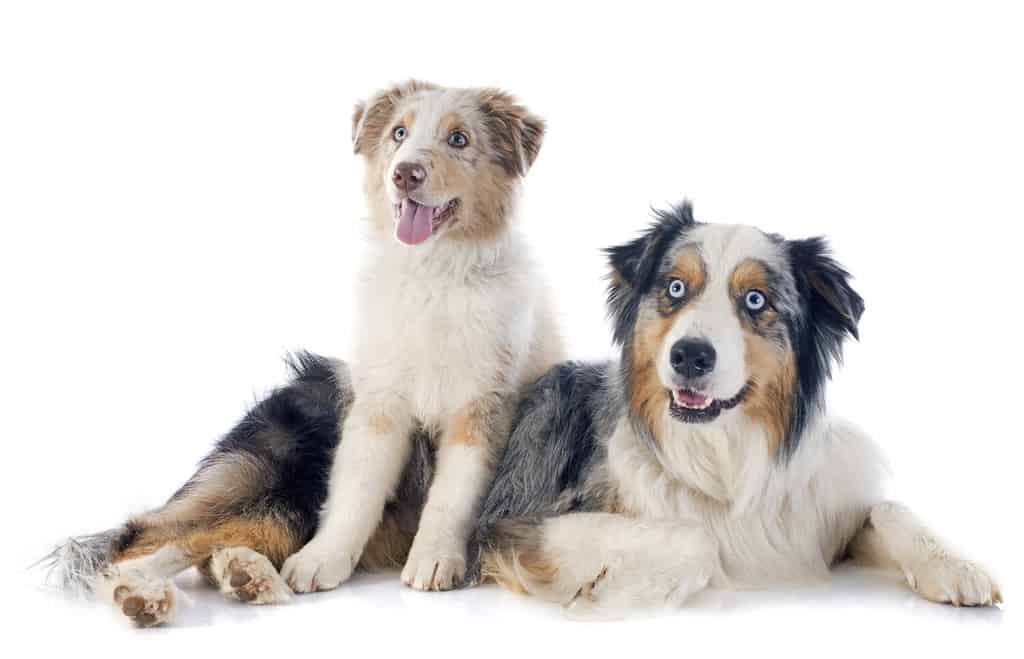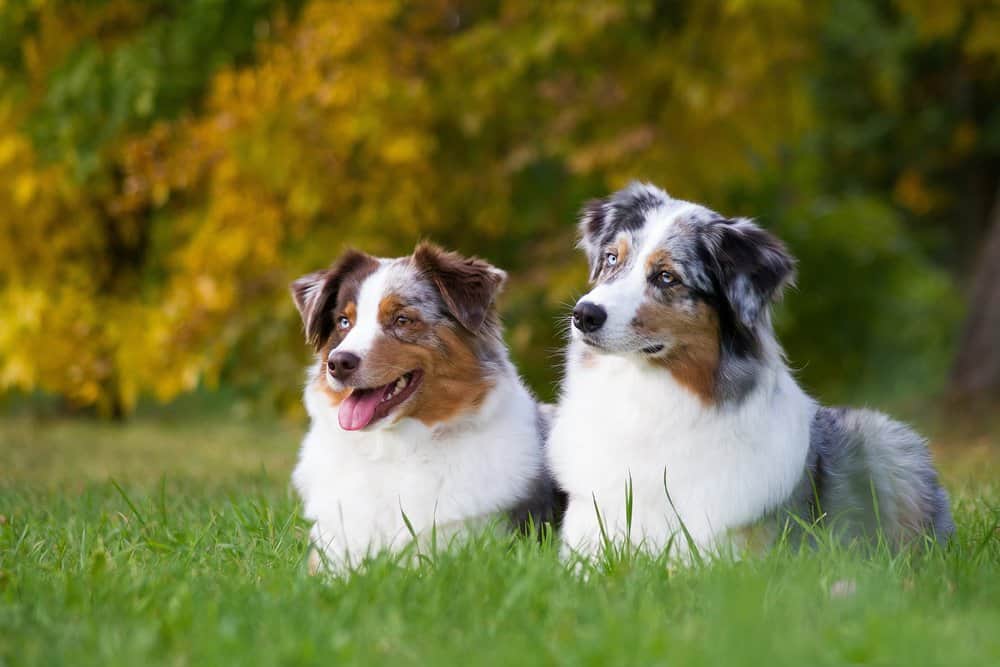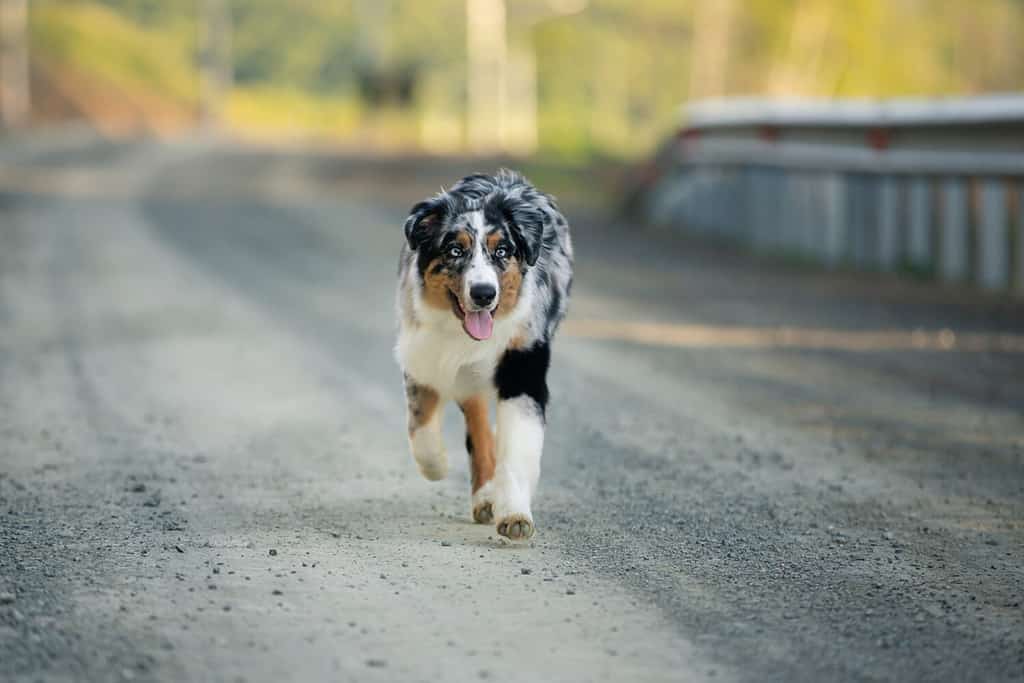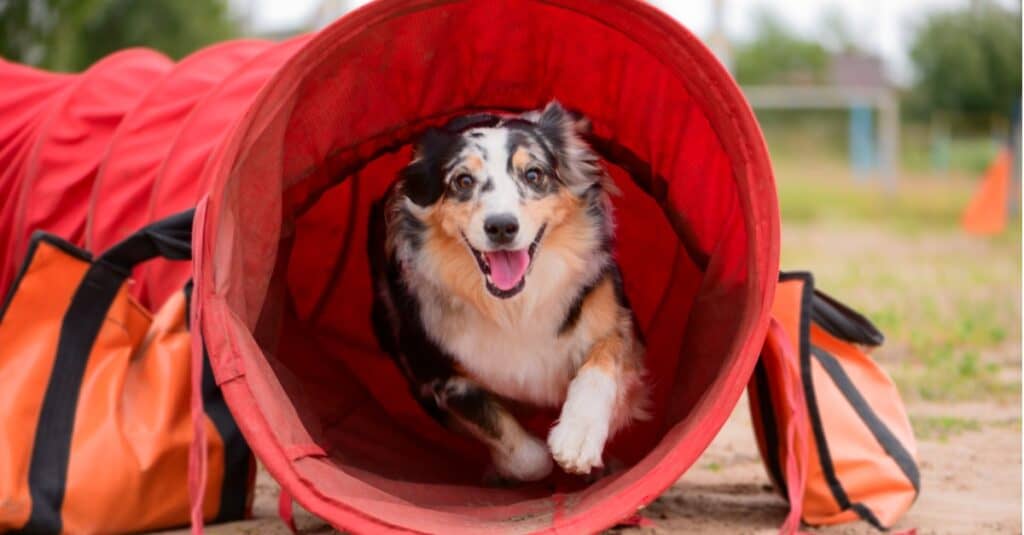If you’re reading this, then it is likely that you’ve either already decided or have been highly considering the adoption of an Australian Shepherd. First and foremost, be reassured that this is an excellent decision. These fun-loving furballs make an ideal addition to any family, as their playful and affectionate personalities are well-suited for adults and children alike. These amazing companions want nothing more than to share their love with their owners and perhaps play more than a few rounds of catch.
Once you’ve decided to welcome an Australian Shepherd into your family, there comes a second decision: Gender. For many breeds, there are important distinctions to be made between the two. These range from apparent physical differences, differences in personality, and even vulnerability toward certain medical conditions.
When looking at a male vs. female Australian Shepherd, these distinctions aren’t too extraordinary. That being said, each gender does have its quirks, and it can never hurt to know as much about your dog and its specifications as possible. So, let’s delve into the world of the Australian Shepherd and discover the traits that distinguish the breed’s males from females.
Comparing The Two Australian Shepherd Genders
| Gender | Temperament | Build | Lifespan | Height | Weight |
|---|---|---|---|---|---|
| Male | Energetic, Tough, Clingy | Muscular | 12-15 years | 20–23 inches | 50–65 pounds |
| Female | Independent, Sensitive, Slightly Less Intense | Muscular, but Leaner | 12-15 years | 18–21 inches | 40–55 pounds |
Physical Traits of a Male vs. Female Australian Shepherd

Australian Shepherds have many of the same physical characteristics across genders.
©iStock.com/Bigandt_Photography
At a glance, you’ll come to find that the physical features of male and female Australian Shepherds aren’t actually too different. Speaking generally, they have the same coat types and similar characteristics. This breed is one that heavily enjoys playtime, so both genders have a set of strong and capable muscles to push them through the heaviest of challenges.
The most substantial difference between the two genders of Australian Shepherds is size. The male of the species can grow to be as large as 65 pounds. This comes complete with massive bones and hair that grows a bit thicker and longer than their female counterparts. Females are usually between 40 and 55 pounds in weight, and while they are still quite bulky, they aren’t quite as muscular as the males.
These traits are due to their long-running history as working dogs, and while females traditionally spent time breeding, males were put to work! That isn’t to say that females don’t have their share of labor, though! Whether it’s herding animals on a farm or maintaining a career as a serving dog, this breed is excellent at whatever job they do. They live to serve their master, but only if they respect and reward them accordingly.
Temperament of a Male vs. Female Australian Shepherd

Male and female Australian Shepherds have personality quirks that are quite distinct.
©cynoclub/Shutterstock.com
The differences in the temperament of the two Australian Shepherd genders are much more apparent than their physical distinctions. While you might not be able to tell them apart from the looks of them, you’ll definitely be able to tell by observing their behavior. While this breed is affectionate, playful, and loyal across genders, there are certain traits that definitely stand out.
Male Temperament
If you’re searching for that classic “man’s best friend” energy, then a male Australian Shepherd might be the way to go. You see, the males of this breed are incredibly dependent and are constantly trying to garner your attention and love. While both genders are notably active, males are much more prone to boredom. If there’s nothing for your Aussie to do, then he may get a bit restless and feel confined. They don’t just want to play; they want to play with their humans.
For active families, a male might be the perfect choice. They’ll follow you around the house and seek your attention incessantly. While this is adorable, bear in mind that it might be extra time-consuming. If things get a bit too much to handle, try inviting over company to keep him moving and distracted. Male Australian Shepherds usually have no issue in meeting and falling in love with new friends!
Female Temperament
On the flip side are female Australian Shepherds, who love their humans but are simultaneously well aware that you love them more. Very self-assured, females don’t require as much attention and mental stimulation as males. If they become bored, they are likely to go and find something to do by themselves instead of waiting around at your feet.
That said, they can sometimes be a bit stubborn and mischievous. This is because they know that they’re adorable, and they count on that fact to get away with their shenanigans. Additionally, females are a bit more reluctant to meet new people. They aren’t prone to be aggressive by any means, but they also won’t lose their minds over the prospect of meeting a new human. This sensitivity might be welcomed, however, in homes that require a dog that’s more alert and on guard.
The Trainability of a Male vs. Female Australian Shepherd

Since Australian Shepherds are so notoriously smart, they are great candidates for training.
©Eve Photography/Shutterstock.com
Now that we’ve gone over both the physical and personality differences of the two genders, it’s time to evaluate how these can impact the trainability of this breed. Australian Shepherds are generally quite receptive to training of all kinds. With enough effort, you can see very grand developments in their abilities. This is because the breed is incredibly intelligent and can understand concepts that you might not expect a dog to be able to grasp. In fact, this breed is so intelligent that you might have some trouble if you don’t put them through at least basic dog training.
Male Australian Shepherds, as we covered, are people pleasers at heart. They have a natural curiosity that makes them more open to trying new things. This kind of attitude is excellent to have in a training environment. Plus, their well-developed muscles allow them to have a lot more success in agility training than their female counterparts. The only downside to training a male Australian Shepherd is that sometimes, their curiosity and excitement can be overwhelming and difficult to manage at first.
Oddly enough, despite their attitudes, female Australian Shepherds are considered easier to train. Since they are a bit calmer than males, they are able to pick up on new commands much faster. The catch to this is that they will only be willing to learn the commands if they have a great deal of respect for you. They need more patience and more encouragement. This isn’t because they have a hard time with training, but rather because the idea of it is uninteresting.
The Health of a Male vs. Female Australian Shepherd

A well-cared-for Australian Shepherd usually lives between 12 and 15 years.
©Anastasiia Cherniavskaia/Shutterstock.com
We know all about how this breed acts, but how about the way it feels? First, let’s discuss their general health regardless of gender. Australian Shepherds have a lifespan that falls somewhere between 12 and 15 years. That doesn’t mean that they won’t live longer than that, and it doesn’t mean that they’ll make it to that age. But it gives a general idea of what owners can expect.
The health of both genders of this breed can be quite similar. That said, there are a few conditions that one gender is more susceptible to develop than the other. For males, the two primary conditions to look out for are prostatic hyperplasia and testicular cancer. Both of these conditions are preventable if the male is fixed. The best time to get your Australian Shepherd fixed is typically while they are still a puppy.
The female Australian Shepherd is much the same. One condition to look out for is mammary cancer, but this is also an illness that is preventable once the dog has been spayed. Another condition that your female Australian Shepherd might develop is uterine infection. These infections are impacted mainly by your dog’s salt intake, so be sure to run their diet by your veterinarian to ensure it’s optimal.
Is An Australian Shepherd Right For You?

The Australian Shepherd breed has a special set of requirements that one should consider before adopting.
©iStock.com/Irina Orlova
We all know that what matters most about a dog isn’t its gender, its appearance, its trainability, or its breed. The most important trait a dog can have is being well-loved. The Australian Shepherd is a breed that is incredibly popular for a variety of reasons, but it is imperative that future owners understand what they are getting themselves into prior to adoption. Don’t wait until you already have the dog in your possession to discover that you don’t have the time, the energy, or the space to give it the environment you know it deserves. Here are a few things that you should consider before taking the leap.
High Levels of Energy
Don’t have the time to dedicate at least an hour’s worth of physical activity to your dog each day? In that case, an Australian Shepherd simply isn’t the breed for you. This kind of dog needs a considerable amount of physical and mental stimulation each day to remain happy. This is a characteristic that reaches beyond gender and encompasses the breed as a whole. It should also be noted that in order to get out this energy, your Aussie must have room to run about. If you are in a small apartment or condo with no yard or play area nearby, then it might be wise to opt for another breed.
Grooming
The Australian Shepherd has a double coat, which means that it needs a lot of attention from the groomers. If you don’t think that you’re someone who can financially handle a dog with such maintenance, it’s probably best to check out other breeds. Another factor that goes hand-in-hand with this is shedding. Expect to find fur nearly everywhere in your home, and learn to love it!
Need For Socialization and Companionship
The last, but certainly not least, aspect for consideration when adopting this breed is that they are incredibly social. So social, in fact, that they can suffer from separation anxiety if split apart from their family for too long. If you want your dog to remain happy and healthy, you need to have at least someone to keep them company for the majority of the day. Of course, no one can be around their pet 24/7, but this breed is one that will suffer greatly if it feels lonely or isolated. If you’re certain you can give your Aussie the time, love, and attention it needs, then it will be the most loving companion you’ve ever had.
Ready to discover the top 10 cutest dog breeds in the entire world?
How about the fastest dogs, the largest dogs and those that are -- quite frankly -- just the kindest dogs on the planet? Each day, AZ Animals sends out lists just like this to our thousands of email subscribers. And the best part? It's FREE. Join today by entering your email below.
Thank you for reading! Have some feedback for us? Contact the AZ Animals editorial team.








